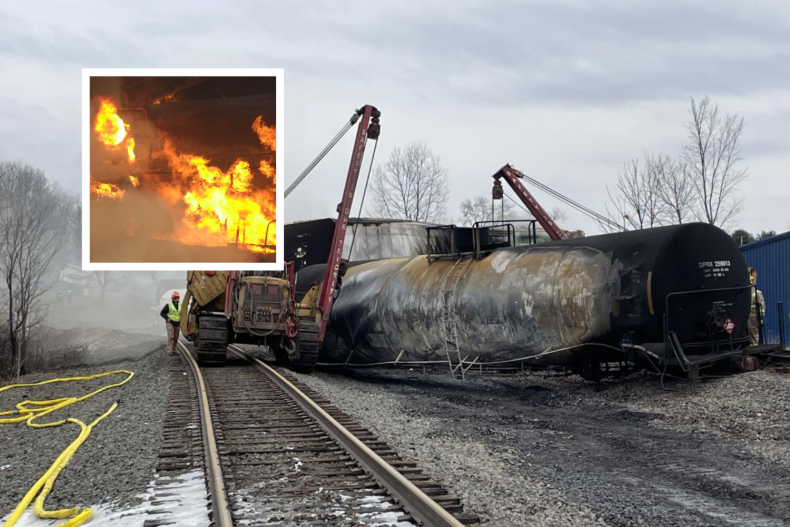Investigation Reveals Lingering Toxic Chemicals From Ohio Train Derailment

Table of Contents
Types of Toxic Chemicals Released and Their Effects
The derailment released a cocktail of hazardous materials, posing significant threats to human health and the environment. Understanding the specific chemicals and their effects is crucial for assessing the long-term impacts.
Vinyl Chloride's Devastating Impact
Vinyl chloride, a known carcinogen, was a major component of the released chemicals. Exposure to vinyl chloride can lead to a range of severe health problems.
- Short-term effects: Nausea, dizziness, headaches, and respiratory irritation.
- Long-term effects: Liver damage, including liver cancer; lung cancer; brain and nervous system damage; and blood disorders.
- Environmental persistence: Vinyl chloride is volatile and can easily spread through air and water, contaminating soil and groundwater for extended periods.
- Governmental response and regulations concerning vinyl chloride: The EPA and other regulatory bodies are involved in monitoring and addressing the contamination, but long-term effects of regulations on vinyl chloride usage are still under review and debate.
Other Hazardous Substances Identified
Beyond vinyl chloride, other hazardous substances identified at the derailment site include butyl acrylate and ethylhexyl acrylate. These chemicals also pose significant health risks.
- Health risks associated with each chemical: Butyl acrylate can cause skin and eye irritation, respiratory problems, and potential central nervous system effects. Ethylhexyl acrylate can also cause skin and eye irritation.
- Synergistic effects of combined chemical exposure: The combined exposure to multiple chemicals may lead to synergistic effects, meaning the overall impact is greater than the sum of individual effects. Further research is needed to fully understand these complex interactions.
- Methods for detecting and measuring these chemicals in the environment: Advanced analytical techniques, such as gas chromatography-mass spectrometry (GC-MS), are employed to detect and quantify these chemicals in soil, water, and air samples.
Extent of Environmental Contamination
The extent of environmental contamination from the Ohio train derailment is a grave concern. The impact on soil, water, and air quality has far-reaching consequences.
Soil and Water Contamination
The soil and water sources near the derailment site are heavily contaminated with various toxic chemicals.
- Testing methods used to assess contamination levels: Samples are collected and analyzed using various methods to determine the concentration of different chemicals in soil and water.
- Areas affected by contamination: The contamination extends beyond the immediate vicinity of the derailment site, impacting nearby water bodies, agricultural lands, and residential areas. The precise extent is still being determined through ongoing testing and monitoring efforts.
- Potential long-term effects on the local ecosystem: The contamination poses a serious threat to the local ecosystem, potentially impacting aquatic life, plant growth, and overall biodiversity.
Air Quality Concerns
Air quality issues persist in the affected areas, raising concerns about long-term respiratory health problems for residents.
- Air quality monitoring data: Continuous air quality monitoring is being conducted to assess the levels of various pollutants in the air.
- Health advisories issued to residents: Health advisories have been issued to residents, recommending precautions to minimize exposure to contaminated air.
- Strategies for mitigating air pollution: Efforts are underway to mitigate air pollution, including the use of air purifiers and improved ventilation systems in affected buildings.
Long-Term Health Impacts and Community Response
The long-term health consequences for residents and the community response to the disaster are critical aspects of this ongoing situation.
Health Concerns for Residents
Residents have reported a wide range of health issues following the derailment, raising concerns about long-term health problems.
- Reported health issues among residents: Reports include respiratory problems, headaches, skin rashes, and other symptoms potentially linked to exposure to toxic chemicals.
- Access to healthcare and support services: Ensuring access to adequate healthcare and support services for affected residents is a major priority.
- Ongoing health monitoring initiatives: Long-term health monitoring programs are crucial to track the health status of residents and assess any long-term health effects.
Community Activism and Advocacy
The community response has been marked by activism and advocacy efforts demanding accountability and stricter regulations.
- Community organizations and their roles: Various community organizations are working to support affected residents and advocate for their rights.
- Legal actions and demands for accountability: Legal actions have been initiated to hold responsible parties accountable for the damage caused by the derailment.
- Calls for stricter regulations on hazardous materials transport: There are growing calls for stricter regulations and improved safety measures to prevent similar incidents in the future.
Cleanup Efforts and Ongoing Investigations
The ongoing cleanup efforts and investigations are crucial for mitigating the long-term consequences of the Ohio train derailment.
The Cleanup Process
The cleanup process is complex and challenging, involving the removal of contaminated soil and water.
- Methods used for soil and water remediation: Various methods, including excavation, filtration, and other remediation techniques, are being employed.
- Estimated timeline for completion: The timeline for completing the cleanup process remains uncertain due to the complexity of the situation.
- Transparency and communication surrounding cleanup efforts: Transparency and effective communication regarding cleanup progress are essential to build public trust.
Ongoing Investigations and Accountability
Investigations into the causes of the derailment are underway, with potential legal repercussions for responsible parties.
- Governmental investigations and their findings: Governmental agencies are conducting thorough investigations to determine the causes of the derailment and identify areas for improvement.
- Potential legal liabilities of involved parties: Legal liabilities for the involved parties, including the railroad company and other entities, are under scrutiny.
- Calls for improved safety regulations: The derailment has renewed calls for improved safety regulations and stricter oversight of hazardous materials transport.
Conclusion:
The Ohio train derailment and its lingering consequences serve as a stark reminder of the potential for catastrophic environmental damage and long-term health risks from hazardous materials transport. The investigation reveals the ongoing presence of toxic chemicals, highlighting the urgent need for comprehensive cleanup efforts, improved safety regulations, and robust support for affected communities. The long-term effects of this disaster will require sustained monitoring, investigation, and accountability. We must demand stronger regulations and improved safety measures to prevent future tragedies caused by toxic chemical spills and Ohio train derailments. Continued vigilance and advocacy are crucial to ensuring the health and safety of those affected and preventing similar incidents in the future. Stay informed about the ongoing investigation and support initiatives advocating for environmental justice and stricter regulations concerning the transport of hazardous materials.

Featured Posts
-
 Talladega Superspeedway 2025 Your Guide To Nascar Jack Link 500 Betting
Apr 28, 2025
Talladega Superspeedway 2025 Your Guide To Nascar Jack Link 500 Betting
Apr 28, 2025 -
 Red Sox Injury Report Latest On Crawford Bello Abreu And Rafaela
Apr 28, 2025
Red Sox Injury Report Latest On Crawford Bello Abreu And Rafaela
Apr 28, 2025 -
 6 3 Twins Win Mets Lose Second Game Of Series
Apr 28, 2025
6 3 Twins Win Mets Lose Second Game Of Series
Apr 28, 2025 -
 Extreme Price Increase For V Mware At And Ts Reaction To Broadcoms Proposal
Apr 28, 2025
Extreme Price Increase For V Mware At And Ts Reaction To Broadcoms Proposal
Apr 28, 2025 -
 Bubba Wallaces Inspiring Visit To Austin Teens Before Cota
Apr 28, 2025
Bubba Wallaces Inspiring Visit To Austin Teens Before Cota
Apr 28, 2025
